There are several things that I love (among others, of course) and two of those are “Period Correct” movies (firearms and manner of dress) and firearms used during those periods. The period that I am addressing is a short period prior to and after the “War of Northern Aggression”, which I feel brought about the greatest change in personal weaponry with regards to revolver firearms – the metallic cartridge.
 I have shot a percussion revolver (reproduction of an 1851 Navy Colt in .36 caliber) although I have never owned one. I have several modern Ruger single-action revolvers, but they are far removed from those that were available to both the North and the South during the period of, say, 1851 and 1890. At that time in history, there were three American firearm manufactures that played leading roles in the advancement of the revolver; Smith and Wesson, Remington, and Colt. Colt was a leader in American ‘wheel guns’ as percussion revolvers like the Colt Paterson (1836), Colt’s Dragoon (1848), and ‘Walker’ Colt (1847) were already major players. Smith & Wesson; however, held one of the major keys to the advancement of the revolver – the Rollin White patent.
I have shot a percussion revolver (reproduction of an 1851 Navy Colt in .36 caliber) although I have never owned one. I have several modern Ruger single-action revolvers, but they are far removed from those that were available to both the North and the South during the period of, say, 1851 and 1890. At that time in history, there were three American firearm manufactures that played leading roles in the advancement of the revolver; Smith and Wesson, Remington, and Colt. Colt was a leader in American ‘wheel guns’ as percussion revolvers like the Colt Paterson (1836), Colt’s Dragoon (1848), and ‘Walker’ Colt (1847) were already major players. Smith & Wesson; however, held one of the major keys to the advancement of the revolver – the Rollin White patent.
SMITH & WESSON:
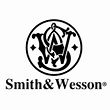 Horace Smith and Daniel B. Wesson came from old New England families. Horace learned the firearms trade while working at the National Armory in Springfield, Massachusetts. Daniel’s experience came from apprenticing with his brother Edwin Wesson, the leading maker of target rifles and pistols in the 1840s.
Horace Smith and Daniel B. Wesson came from old New England families. Horace learned the firearms trade while working at the National Armory in Springfield, Massachusetts. Daniel’s experience came from apprenticing with his brother Edwin Wesson, the leading maker of target rifles and pistols in the 1840s.
The two men formed their first partnership in 1852 in Norwich, Connecticut, with the aim of marketing a lever action repeating pistol that could use a fully self-contained cartridge. This first pistol venture was not a financial success, and by 1854 the company was having financial difficulties.
The original Smith & Wesson Factory in Springfield, Massachusetts, when faced with their financial difficulties, were forced to sell their company to a shirt manufacturer by the name of Oliver Winchester. In 1866, using the original lever action design created by Smith & Wesson, Winchester’s company emerged as the famous Winchester Repeating Arms Co.
In 1856 Smith & Wesson formed their second partnership to produce a small revolver designed to fire the Rimfire cartridge they patented in August of 1854. This revolver was the first successful fully self-contained cartridge revolver available in the world. Smith & Wesson secured patents for the revolver to prevent other manufacturers from producing a cartridge revolver – giving the young company a very lucrative business.
The partners realized that when their patents expired they would need a new design to maintain their market superiority. The new design was completed in 1869 and the company began marketing it in 1870. The Model 3 American, as it became known in the United States, was the first large caliber Original Smith & Wesson Factory in Springfield, Massachusetts cartridge revolver and established Smith & Wesson as a world leader in handgun manufacturing. The two most important customers for the new revolver were the United States Cavalry, which purchased 1,000 units for use on the Western Frontier, and the Russian Imperial Government.
Colt; however, had been around earlier than Smith and Wesson, but up until 1870 Smith & Wesson held one key that was crucial to Colt moving forward.
COLT MANUFACTURING COMPANY:
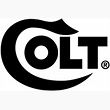 The Colt revolving cylinder concept is said to have occurred to Sam Colt while serving as a seaman aboard the ship Corvo. He observed a similar principle in mechanical workings of the ship, generally believed to be the capstan or the windlass. It was on the ship that Sam carved the wooden representation of his idea. While the design was simple & applicable to both longarms & sidearms, his idea was not an instant success. Many people still preferred traditional flintlock muskets or pistols to the revolver.
The Colt revolving cylinder concept is said to have occurred to Sam Colt while serving as a seaman aboard the ship Corvo. He observed a similar principle in mechanical workings of the ship, generally believed to be the capstan or the windlass. It was on the ship that Sam carved the wooden representation of his idea. While the design was simple & applicable to both longarms & sidearms, his idea was not an instant success. Many people still preferred traditional flintlock muskets or pistols to the revolver.
In 1836, Sam’s entrepreneurial career began at age 22, opening his first plant in Paterson, New Jersey with the help of a successful uncle. He soon developed & produced the pocket, belt, and holster model pistols along with two types of rifles. In these models, known as percussion guns, the gunpowder & bullets were loaded into the revolving cylinder, the primer was placed in a nipple on the outside of the cylinder, and then the primer would be struck by the hammer when the trigger was pulled. Despite favorable performance, sales were sluggish & the plant closed in 1842. After the closing of the Paterson plant, Sam began focusing on other ideas, including waterproof ammunition, underwater mines, and also worked with inventor Samuel Morse on the telegraph.
In 1845, units of the US Dragoon forces & Texas rangers were fighting the Indians in Texas, and contributed their success to Colt’s firearms. As a result, Captain Samuel H. Walker of the US Army collaborated with Colt in designing a new, more powerful revolver. Dubbed the “Walker”, the US Ordnance Department ordered one thousand of the new pistols. Without a factory, Colt turned to Eli Whitney Jr. who had a factory in Connecticut, to fill the thousand gun order in 1847.
In 1851, Sam became the first American manufacturer to open a plant in England, solidifying his reputation in the international market. Sam also began purchasing land on the South Meadows, an area of Hartford on the Connecticut River. The factory became operational in 1855, incorporated as Colt’s Patent Fire Arms Manufacturing Company. Colt, aware of the achievements made in New England’s machine tool industry, specified interchangeable parts for his guns. Colt’s aggressive marketing campaigns were just as important, and many of his highly decorated & engraved guns won prizes at international fairs, and were also presented publicly to heads of state, including Czar Nicholas I of Russia, King Frederick VII of Denmark, and King Charles XV of Sweden. By 1856, Colt was producing 150 weapons a day, and the reputation of models like the 1851 Navy and 1849 Pocket as accurate, reliable, and of the finest workmanship & design had spread throughout the world.
Colt’s success brought him fame & fortune. He became one of the ten wealthiest businessmen in the US, became a pillar of the Hartford community, and was awarded the honorary title of “Colonel” by the governor of Connecticut. He and his wife Elizabeth built Armsmear, his private mansion with greenhouses & formal gardens at the western edge of the armory property, where it still stands today.
Sam’s health began to fail in 1860 as the country moved towards the Civil War. Prior to the formal declaration of war, Colt continued to supply his customers in the southern states. Once official, Colt supplied only the Union forces. By the end of 1861, the factory was running at full capacity with over one thousand employees and annual profits exceeding a quarter million dollars. On January 10, 1862, at age 47, Samuel Colt died, having produced over 400,000 firearms and building a fortune worth fifteen million dollars, an incredible sum for the time.
Sam’s early death left his industrial empire and fortune to his widow Elizabeth Hart Jarvis Colt. Elizabeth’s inner strength and deep love for her husband gave her the determination to maintain ownership of the company and see that his legacy lived on.
In 1864, the Colt Armory burned to the ground, causing the suspension of all but limited military production for three years. Under Elizabeth’s direction, the factory was rebuilt and made to be as fireproof as possible. Just after the rebuilding of the factory, Colt began building Dr. R.J. Gatling’s machine guns, a semiautomatic firearm operated by a hand crank that turned a cluster of six to ten barrels while feeding ammunition into the breech.
Further change & growth came in the 1870’s when Colt began to manufacture revolvers that used self-contained metallic cartridges. This change gave birth to the famous Colt Single Action Army Revolver, which was introduced in 1873. The Single Action Army was an immediate sales success and soon became known as “the gun that won the West”. Between 1873 and 1941, Colt produced more than 350,000 Single Action Army revolvers, including about 40,000 of the .45 caliber model produced for the U.S. Government. Famous proponents of the revolver include Buffalo Bill Cody, Bat Masterson, General George Patton, and Teddy Roosevelt. Single Action Army production continues to this day. Product expansion continued through the end of the 19th century to include the Model 1877 and Model 1878 double action revolvers, the New Army & New Navy models with the first swing out cylinders, concealable derringers, shotguns, and rifles.
In the mix; however, was Eliphalet Remington
REMINGTON ARMS:
 Legend has it that a young Eliphalet Remington II believed he could build a better gun than he could buy, and he set out to craft such a gun on his father’s forge located at Ilion Gulch, New York. In the autumn of 1816, Eliphalet entered a shooting match with his new flintlock rifle, and while he only finished second, his handmade rifle was a success. Orders for new Remington-made rifles and barrels began to accumulate from the many other contestants, and before Eliphalet left the shooting field, he was in the gun business.
Legend has it that a young Eliphalet Remington II believed he could build a better gun than he could buy, and he set out to craft such a gun on his father’s forge located at Ilion Gulch, New York. In the autumn of 1816, Eliphalet entered a shooting match with his new flintlock rifle, and while he only finished second, his handmade rifle was a success. Orders for new Remington-made rifles and barrels began to accumulate from the many other contestants, and before Eliphalet left the shooting field, he was in the gun business.
In 1828, Remington moved its operations from Ilion Gulch to a site close to the newly constructed Erie Canal. This site, in Ilion, New York, is part of the property on which the Ilion firearms plant sits today.
In 1865, the partnership of E. Remington & Sons was incorporated as a stock company. Over the years, the partnership and the succeeding corporation developed the first hammerless solid breech repeating shotgun, the first hammerless autoloading shotgun, the first successful high-power slide action repeating rifle, and the first lock breach autoloading rifle. In 1865-66, Remington produced the state-of-the-art Rolling Block Rifle.
In an effort to diversify their holdings, Schuyler, Hartley & Graham purchased two small New England cartridge companies in 1867I. These companies were later closed, and the equipment moved to a new site in Bridgeport, Connecticut. On August 9, 1867, the Union Metallic Cartridge Company was incorporated. It was particularly noted for its development of metallic cartridges. It and its successor company subsequently developed the first paper shotshells successfully manufactured in the United States, the first primer adapted to smokeless powder; the first battery cup for best quality paper shotshells; the first cartridges for automatic pistols; the first standard high-power smokeless cartridges for big game autoloading rifles; the first .410 bore gauge shotshell in the United States; the first nickeled primer; the first oil-proof automatic pistol cartridges; and the first completely wetproof loaded shells, including top wad, crimp and body.
In 1873, E. Remington & Sons embarked on a new venture, and in September of 1873, the first Remington typewriters were produced. However, firearms will still being manufactured.
1886 – Remington sells the typewriter business. This business would later become Remington Rand, then Sperry Rand.
1888 – In March 1888, E. Remington & Sons was acquired by Marcellus Hartley and partners. E. Remington & Sons was reorganized, and the new company was named the Remington Arms Company. In later years, in order to better utilize the potential of the Remington Plant, the company would produce sewing machines and cash registers.
MY PERSONAL SELECTION:
While I could never be able to shoot nor own all of the handguns available to man at this early time in history, there were five revolvers that stand out in my mind that, and that I believe, shaped the future of revolvers:
- 1858 Remington Army Conversion
- 1870 Smith & Wesson Model 3 “American”
- 1871-1872 Colt Open Top Revolver Conversion
- 1873 Colt Single Action Army
- 1875 Remington New Army
It is my goal to have a reproduction of all five of these firearms, and thanks to “Spaghetti Westerns” and companies like Uberti and Pietta, reproductions of past revolvers is within my reach. I don’t want “Hollywood” guns; I want something as close to the originals as possible, but with modern materials, manufacturing, and ammunition.
1858 REMINGTON NEW ARMY:
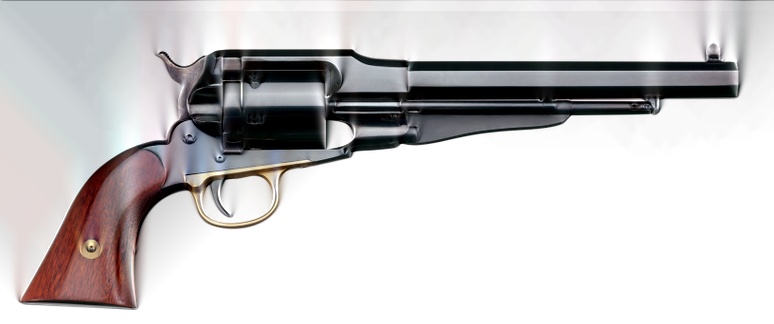 My first attempt of having a reproduced piece of history, was acquiring the 1858 Remington Army Conversion although full production of the revolver did not start until 1861. The 1858 Remington New Army Model was the first revolver to be “converted” from a percussion piece to a revolver that utilized a cylinder housing 6 self-contained cartridges. This was a milestone for Remington, as Remington was able to purchase cylinders from Smith & Wesson by paying royalty fees to Smith & Wesson; whereas, Colt did not. Both Colt and Remington produced percussion revolvers, but many felt (as I feel now) that the Remington was a better and more durable unit due to its top-strap, which the Colt revolver did not incorporate until 1873. Both revolvers; however, shared battle in field and aboard ships throughout the Civil War. In 1864, Colt’s plant burned to the ground and only military-use models of firearms were produced. Remington took the lead on and off of the battlefield in “cartridge” revolvers with the 1858 Remington New Army Model.
My first attempt of having a reproduced piece of history, was acquiring the 1858 Remington Army Conversion although full production of the revolver did not start until 1861. The 1858 Remington New Army Model was the first revolver to be “converted” from a percussion piece to a revolver that utilized a cylinder housing 6 self-contained cartridges. This was a milestone for Remington, as Remington was able to purchase cylinders from Smith & Wesson by paying royalty fees to Smith & Wesson; whereas, Colt did not. Both Colt and Remington produced percussion revolvers, but many felt (as I feel now) that the Remington was a better and more durable unit due to its top-strap, which the Colt revolver did not incorporate until 1873. Both revolvers; however, shared battle in field and aboard ships throughout the Civil War. In 1864, Colt’s plant burned to the ground and only military-use models of firearms were produced. Remington took the lead on and off of the battlefield in “cartridge” revolvers with the 1858 Remington New Army Model.
As a side note, the 1858 New Army Conversion rev9olver was used by Clint Eastwood in the movie ‘Pale Rider’ (1985)
1870 SMITH & WESSON MODEL 3 “AMERICAN”:
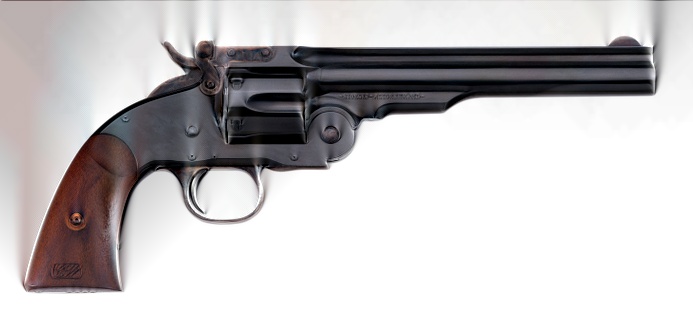 It wasn’t until after the Civil War (1861 – 1865) that Smith and Wesson was able to revolutionize the revolver and did so with the 1870 Smith and Wesson Model 3 revolver. The Smith & Wesson Model 3 was a single-action, cartridge-firing, top-break revolver produced by Smith & Wesson from circa 1870 to 1915. It was not; however, known as the “Schofield” revolver until 1875 when the US Ordnance Board granted Smith & Wesson a contract to outfit the military with Model 3 revolvers incorporating the design improvements of Major George W. Schofield (known as the “Schofield revolver”), providing that they could make the revolvers fire the .45 Colt (AKA “.45 Long Colt”) ammunition already in use by the US military. Smith & Wesson instead developed their own, slightly shorter .45 caliber round, the .45 Schofield, otherwise known as the .45 S&W.
It wasn’t until after the Civil War (1861 – 1865) that Smith and Wesson was able to revolutionize the revolver and did so with the 1870 Smith and Wesson Model 3 revolver. The Smith & Wesson Model 3 was a single-action, cartridge-firing, top-break revolver produced by Smith & Wesson from circa 1870 to 1915. It was not; however, known as the “Schofield” revolver until 1875 when the US Ordnance Board granted Smith & Wesson a contract to outfit the military with Model 3 revolvers incorporating the design improvements of Major George W. Schofield (known as the “Schofield revolver”), providing that they could make the revolvers fire the .45 Colt (AKA “.45 Long Colt”) ammunition already in use by the US military. Smith & Wesson instead developed their own, slightly shorter .45 caliber round, the .45 Schofield, otherwise known as the .45 S&W.
The Smith & Wesson Model 3 revolver was the first to utilize a “Top Break” top strap that enabled the user to quickly un-load and load cartridges from the rear of an exposed cylinder.
1871 – 1872 COLT OPEN TOP REVOLVER:
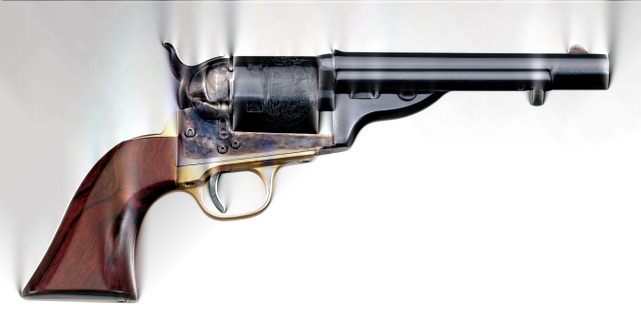 When Rollin White’s request of extension for his breech-loading revolvers patent was rejected by the American Government in January 1870 the Colt’s Patent Fire Arms Manufacturing Company started working on its own metallic cartridge rear-loaders. Up until then, the Colt Company continued converting muzzle-loading percussion revolvers into rear-loaders until 1878, but in 1871 Colt’s had patented at least two rear-loading revolvers using metallic cartridges: the Colt House Revolver and the Open Top. The House revolver went into production the same year in 1871 but the Open Top didn’t start production until 1872. The major distinction between the 1871/1872 Colt open-top revolvers over previous endeavors at open-top “conversions” was that the 1871/1872 Colt Open Top revolver was the first revolver from Colt that was a true “cartridge” revolver.
When Rollin White’s request of extension for his breech-loading revolvers patent was rejected by the American Government in January 1870 the Colt’s Patent Fire Arms Manufacturing Company started working on its own metallic cartridge rear-loaders. Up until then, the Colt Company continued converting muzzle-loading percussion revolvers into rear-loaders until 1878, but in 1871 Colt’s had patented at least two rear-loading revolvers using metallic cartridges: the Colt House Revolver and the Open Top. The House revolver went into production the same year in 1871 but the Open Top didn’t start production until 1872. The major distinction between the 1871/1872 Colt open-top revolvers over previous endeavors at open-top “conversions” was that the 1871/1872 Colt Open Top revolver was the first revolver from Colt that was a true “cartridge” revolver.
But why is the Colt 1871 – 1872 Open Top revolver such a key revolver for Colt? It was actually the failure of the revolver that led to the most popular single-action revolver of all time.
You see, up until the Colt 1871 – 1872 Open Top revolver both Colt and Remington was updating old percussion revolvers to accept the new metallic cartridges. Revolvers circa 1851 and 1860 were updated after Remington began updating the 1858 Remington New Army.
Bound by the Rollin White patent (#12,648, April 3, 1855) and not wanting to pay a royalty fee to Smith & Wesson (as did Remington), Colt could not begin development of bored-through revolver cylinders for metallic cartridge use until April 4, 1869.
The 1871/1872 version of the open-top revolver, then chambered for the .44 caliber rounds, was submitted to the US Army for testing in 1872. The Army rejected the pistol and asked for a more powerful caliber with a stronger frame. Mason redesigned the frame to incorporate a topstrap, similar to the Remington revolvers, and placed the rear sight on the rear of the frame; he consulted with Richards on some other improvements. The first prototype of the new gun was still chambered in .44 rim fire, but this new gun was chambered for the newest caliber known as the .45 Colt. This new design started production in 1873, giving birth to a new model, the Colt Single Action Army, and a new serial numbering. The 1871/1872 Colt Open Top revolver was the last of its kind for Colt. This, to me, the fact that the 1871/1872 Colt open top revolver was the first of Colt’s cartridge revolvers, and that actually led to the development of the Colt 1873 Single Action Army revolver, is why I have a reproduction of this revolver – it was an end of an era for Colt revolvers.
As a side note, the 1860 Richards-Mason conversion was used by Clint Eastwood (and several other actors) in the film ‘Outlaw Josie Wales’ (1976) during scenes that actually called for firing the revolver (blanks, of course); otherwise, 1860 percussion revolvers were used for ‘static shots’. In actuality, the Richard’s conversions did not take place until after 1870 – long after the time period depicted in the movie.
1873 COLT SINGLE ACTION ARMY:
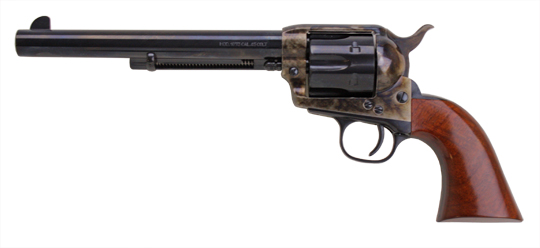 The original 1873 Colt New Action Army had a top strap, sported a 7.5-inch barrel, and was chambered for six .45 Colt cartridges. Many variations have been manufactured since by many companies and the sheer numbers of reproduction revolvers testify to the staying power of the original Colt “Peacemaker” revolver.
The original 1873 Colt New Action Army had a top strap, sported a 7.5-inch barrel, and was chambered for six .45 Colt cartridges. Many variations have been manufactured since by many companies and the sheer numbers of reproduction revolvers testify to the staying power of the original Colt “Peacemaker” revolver.
There are actually 3 “generations” of the 1873 Colt Single Action Army revolvers; the P1, P2, and P3. P1 revolvers were manufactured from 1873 through 1941. P2 revolvers were manufactured from 1956 to 1974. P3 revolvers have been manufactured from 1976 through today’s time.
As with most revolvers, various barrel lengths and configurations apply to the 1873 Colt Single Action Army revolver. I’ll touch on that later.
Although I have Ruger single-action revolvers that are a modern take-off of the original colt design with modern material and manufacturing, plus the addition of safeties that are a slap-in-the-face of true single-action connoisseurs, the desire to have a 1873 Colt Single Action Army reproduction in my possession has driven me to find one. As of this writing, I have a reproduction by Uberti on order. While many favor the shorter barreled version, I wanted one as close to the original as modernly possible; 7.5-inch barrel and chambered in the original production .45 Colt. Hopefully, I’ll be shooting one soon.
REMINGTON MODEL 1875 SINGLE ACTION ARMY:
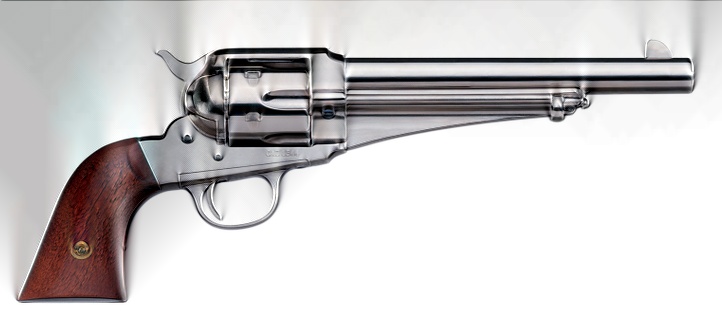 Remington Model 1875 Single Action Army (a.k.a. Improved Army or Frontier Army) was a revolver by the E. Remington & Sons. It was a based upon the successful Remington Model 1858 with both revolvers having the same size, appearance, and the removable cylinder. The new 1875 Remington differed mainly from the older 1858 percussion model by having a bored through cylinder chambered for metallic cartridges. Thus, in 1875, Remington entered the cartridge revolver market with this big-frame, army style revolver, intended to compete with the Colt Peacemaker. Ordinary citizens and Old West lawmen alike recognized the sturdy quality of the new Remington revolvers. This design was followed by the Model 1888 and the Model 1890.
Remington Model 1875 Single Action Army (a.k.a. Improved Army or Frontier Army) was a revolver by the E. Remington & Sons. It was a based upon the successful Remington Model 1858 with both revolvers having the same size, appearance, and the removable cylinder. The new 1875 Remington differed mainly from the older 1858 percussion model by having a bored through cylinder chambered for metallic cartridges. Thus, in 1875, Remington entered the cartridge revolver market with this big-frame, army style revolver, intended to compete with the Colt Peacemaker. Ordinary citizens and Old West lawmen alike recognized the sturdy quality of the new Remington revolvers. This design was followed by the Model 1888 and the Model 1890.
So why do I consider the Remington Model 1875 Single Action Army over the 1888 or 1890 models? The 1875 Remington New Army was a first true cartridge revolver for Remington and not a conversion as was the 1858 version. The Remington Model 1875 Single Action Army has a fluted cylinder, a round barrel (a change from the octagon barrel), and the barrel shortened to 7.5 inches. The main reason for my selection; however, was because the Remington Model 1875 Single Action Army was the last revolver to incorporate the “sail” in its design. The “sail” as it is sometimes called (also a “web”) added to the structural integrity of the revolver and also set it apart from the Colt design. I would imagine that the “sail” was also extremely hazardous to a foe’s head when it was cracked over his numb skull; something that “Wild Bill” Hickock was famous for (yes that is recorded history and not speculation on my part). An intermediate (transitional) model of cartridge revolver was introduced in 1888 called the “New Model Pocket Army”, which lacked the “sail” and the 1890 Remington single-actions kept the solid frame and similar styling of the 1875 model, but lacked the large web under the ejector rod housing and equipped with checkered rubber grips.
SIZE DOES MATTER:
It seems that a common theme runs through early revolvers and later semi-automatic pistols – and that is barrel length.
With revolvers, the “Cavalry” model was usually a revolver with an 8” or 7.5” barrel. This could equate to the “Government” model colt sizing for the 1911 semi-automatic pistol with a 5” barrel.
Artillery models of early revolvers usually had a 5.5” barrel, which would equate to the “Commander” size Colt 1911 pistol with its 4.25” barrel.
Shorter barreled versions of early revolvers were sometimes referred to as “Civilian”, “Gun Fighter” or “Sheriff” models, which might be compared to the “Officer” version of the Colt 1911 pistol with a 3.5” barrel.
ONWARD AND BACKWARD:
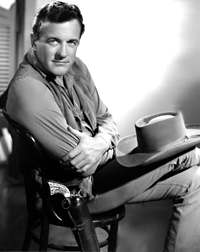 Perhaps there is an iconic reason for owning reproduction firearms of original barrel length, as well as a trip down memory lane. Matt Dillon (Gunsmoke) packed a Colt single action model 1873 71/2 inch barrel in 45 caliber. It was an actual antique made in 1895, not a modern day copy. When it sold at auction along with the gun and holster were papers from Stembridge stateing it was the gun used in the series along with an affidavit from James Arness himself. It sold for $15,000.00.
Perhaps there is an iconic reason for owning reproduction firearms of original barrel length, as well as a trip down memory lane. Matt Dillon (Gunsmoke) packed a Colt single action model 1873 71/2 inch barrel in 45 caliber. It was an actual antique made in 1895, not a modern day copy. When it sold at auction along with the gun and holster were papers from Stembridge stateing it was the gun used in the series along with an affidavit from James Arness himself. It sold for $15,000.00.
Clint Eastwood used reproductions of Colt Open Top and Remington closed top revolvers in several movies and included both percussion and cartridge revolvers as the scenes demanded. Most notable was; Outlaw Josie Wales, Man with No Name, and Pale Rider.
The Smith & Wesson No. 3 revolver was seen in the movie “Unforgiven” and which was used in scenes with the ‘Schofield Kid’ (Jaimz Woolvett) and William Munny (Clint Eastwood).
Of course, reproductions of the 1873 Colt Single Action Army revolver have been used (with various barrel lengths) in too many western films and T.V. series to count.
Reproductions of early revolvers are simply fun to shoot and are a welcome break from shooting my more modern pistols. The problem is that having reproductions of early revolvers is habit forming and sometimes you have to decide when to draw the line They are like potato chips because you just can’t have one, and like “National Treasure”, one mystery leads to the next.
The details for my personal selections are shown below:
- 1858 Remington Army Conversion, .45 Colt, steel, 8” barrel (Calvary)
- 1870 Smith & Wesson Model 3 “American”, .45 Colt, steel, 6.5” barrel
- 1871-1872 Colt Open Top Revolver, .45 Colt, steel frame and barrel, brass backstrap and trigger guard, 5.5” barrel (Artillery)
- 1873 Colt Single Action Army, .45 Colt, 7.5” barrel (Calvary)
- 1875 Remington Single Action Army, .45 Colt, steel, 7.5” barrel (Calvary)
Although these reproductions can be found in various calibers, I wanted to stick with one (the .45 LC) throughout the collection. Note that none of the above are in stainless steel, and as much as I like stainless steel in any handgun or rifle, stainless steel was not around in those days and nickel plating just does not wear well with time. There is nothing like a worn blued-revolver with a fine patina, developed over years of wear and tear and a great set of wood stocks to hold it with.
Although the Ruger “Vaquero” might have been a better choice for the 1873 Colt Single Action Army, it is no longer manufactured in the original 7.5” barrel length, is very hard to find in that barrel length, and much more expensive than the Uberti model. Also, even though the “Vaquero” is a Ruger, “Cowboy” ammunition is still recommended – and that, as far as I’m concerned, puts it on par with Uberti’s version of the 1873 Colt Single Action Army.
 There has to be other single-action cartridge revolvers that interest me, and of course, there are many. For example, who would not want a Colt “Birdshead” single-action revolver, a Colt “Bisley”, or a “Man with No Name” 1860 Colt revolver? Who could pass up the chance to own a six-gun that was carried by the likes of ‘Bat Masterson’, ‘Billy the Kid’, ‘Wild Bill Hickock’, or even ‘The Duke’? A modern reproduction of these firearms makes that possible.
There has to be other single-action cartridge revolvers that interest me, and of course, there are many. For example, who would not want a Colt “Birdshead” single-action revolver, a Colt “Bisley”, or a “Man with No Name” 1860 Colt revolver? Who could pass up the chance to own a six-gun that was carried by the likes of ‘Bat Masterson’, ‘Billy the Kid’, ‘Wild Bill Hickock’, or even ‘The Duke’? A modern reproduction of these firearms makes that possible.
And, who says that a single-action revolver cannot be used for self-defense? A pair of 5.5” barreled 1873 Colt “Peacemakers” in a bedroom drawer, with each stoked with 5 rounds of ammunition, are as effective today as they were in the past. After all, 230-grain .45 LC bullets are still 230-grain .45 LC bullets when traveling at 850 fps or so.
WRAPPING THINGS UP:
While my current interest lies in enjoying ‘conversion’ revolvers, I also have in interest in building and shooting my own brace of post-revolutionary, muzzle-loading ‘Kentucky’ pistols or maybe a brace of flintlock ‘Pirate’ pist0ls. That; however, is another story for another time, and hopefully, one that I will still be around to write.
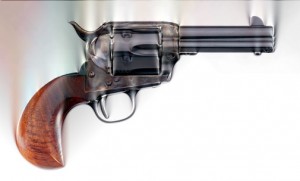 Perhaps you might want to take a break from the here and now? You have one or more modern rifles, shotguns, revolvers, and pistols so plunk down a few dollars and pick up a reproduction of an early revolver, place yourself in a time when the West was truly wild and civil strife was at its height, shoot the revolver, and better understand what it was like in those days of soldiers, desperadoes, and Indians crying out for your blood. You will quickly realize why multiple handguns were carried by many in their times of need and you will quickly appreciate what we have today. After all, self-defense needs have changed – or have they?
Perhaps you might want to take a break from the here and now? You have one or more modern rifles, shotguns, revolvers, and pistols so plunk down a few dollars and pick up a reproduction of an early revolver, place yourself in a time when the West was truly wild and civil strife was at its height, shoot the revolver, and better understand what it was like in those days of soldiers, desperadoes, and Indians crying out for your blood. You will quickly realize why multiple handguns were carried by many in their times of need and you will quickly appreciate what we have today. After all, self-defense needs have changed – or have they?
RESOURCES AND ATTRIBUTIONS:
- Rollin White: https://en.wikipedia.org/wiki/Rollin_White
- Remington Model 1858: https://en.wikipedia.org/wiki/Remington_Model_1858
- Smith & Wesson Model 3: https://en.wikipedia.org/wiki/Smith_%26_Wesson_Model_3
- Colt Model 1871-72 Open Top: https://en.wikipedia.org/wiki/Colt_Model_1871-72_Open_Top
- Colt Single Action Army: https://en.wikipedia.org/wiki/Colt_Single_Action_Army
- Remington Model 1875: https://en.wikipedia.org/wiki/Remington_Model_1875
- Uberti: http://www.uberti.com/
- Cimarron Firearms: http://cimarron-firearms.com/
- Taylor & Company, Inc.: http://www.taylorsfirearms.com/
- E.M.F Company, Inc.: http://www.emf-company.com/
- 1871 Navy Colt Conversion (Early Version) by A. Uberti: https://guntoters.com/blog/2015/09/01/1871-navy-colt-conversion-early-version-by-a-uberti/
- 1858 Remington New Army Conversion by A. Uberti: https://guntoters.com/blog/2015/08/29/1858-remington-new-army-conversion-by-a-uberti/
![]()


One Response to Rediscovering (Early) Revolvers